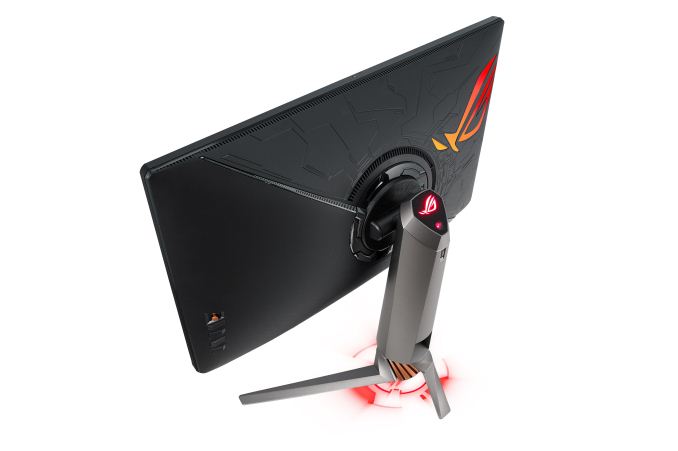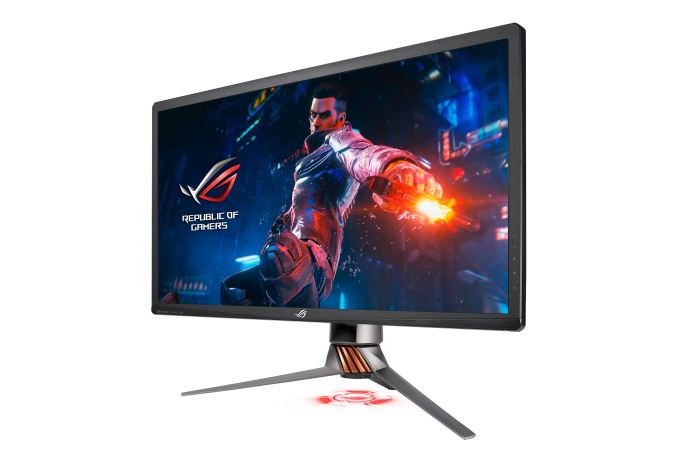The Asus ROG Swift PG27UQ G-SYNC HDR Monitor Review: Gaming With All The Bells and Whistles
by Nate Oh on October 2, 2018 10:00 AM EST- Posted in
- Monitors
- Displays
- Asus
- NVIDIA
- G-Sync
- PG27UQ
- ROG Swift PG27UQ
- G-Sync HDR
The (Asus) G-Sync HDR Experience: Premium Panel for Premium Price
In the end, gamers are given the ultimate guidance with the price point: $2000. The cost doesn't pull any punches, and while it may not be explicitly communicated to consumers, the price is all about the panel functionality, while everything else takes the backseat. Though we can only say this directly about the Asus PG27UQ, this is presumably the case for Acer's Predator X27, which shares the connectivity, large physical design, and active cooling setup.
Some of this is out of Asus's hands, and with the G-Sync HDR module's capabilities and limitations, something that they can only package up and support the best they can. Manufacturers on the display design side would be limited in expanding the basic range of use of G-Sync HDR. Some aspects are even out of NVIDIA's hands when it comes to HDR support in the OS, which goes back to Windows' historically poor management of anything non-SDR and non-sRGB; if the monitors were ready before the Windows 10 April 2018 Update, ease-of-use would've been a big issue.
As one of two current G-Sync HDR implementations, the Asus PG27UQ is also just one of three VESA DisplayHDR 1000 certified products, alongside the Acer counterpart and a Phillips 4K TV, and one of three UHDA Premium certified monitors, alongside two proviz monitors. So by certifications, it would be one of the best HDR PC monitors on the consumer market anyway, G-Sync or otherwise. It seems more likely than not that the 35-inch and 65-inch models are not imminently ready, although resolving firmware issues with FALD backlighting should be a shared investment between them. But for now, G-Sync HDR can only truly stretch its legs in a niche case: single-monitor non-silent PC gaming with HDR titles on NVIDIA G-Sync HDR supporting hardware powerful enough to target 4Kp144 target. The last bit is already niche on its own: the GeForce GTX 1080 Ti was the first card to really hit 60fps on no-compromises 4K, and both AMD and NVIDIA have stepped back from multi-GPU and multi-card solutions.
As an aside, we know now 144fps is perhaps even further out given that NVIDIA's next generation offering of the GeForce RTX 2080 Ti is more-or-less in the Titan V gaming performance bracket, which is to say it's only about 37% faster than the GTX 1080 Ti. The majority of this review was done prior to the RTX 2080 Ti and RTX 2080 launch, but doesn't fundamentally alter the core premise of 4Kp144 being out-of-reach.
And when you're paying more dollars than most people have horizontal pixels on their screen, especially when that price is especially baked in to that use case, that niche becomes extremely relevant. There's no price tiering right now in terms of non-4K G-Sync HDR or non-HDR 4Kp144 G-Sync, so pursuing either combination still leaves you at the $2000 price point. So let's find out if the prospect of playing PC games with the cutting-edge of 2018 visuals measure up.












91 Comments
View All Comments
crimsonson - Tuesday, October 2, 2018 - link
Someone can correct me, but AFAIK there are no native 10 bit RGB support in games. 10-bit panel would at least improve its HDR capabilities.FreckledTrout - Tuesday, October 2, 2018 - link
The games that say they are HDR should be using 10-bit color as well.a5cent - Wednesday, October 3, 2018 - link
Any game that supports HDR uses 10 bpp natively. In fact, many games use 10 bpp internally even if they don't support HDR officially.That's why a HDR monitor must support the HDR10 video signal (that's the only way to get the 10 bpp frame from the GPU to the monitor).
OTOH, a 10 bit panel for gaming typically won't provide a perceptible improvement. In practice, 8bit+FRC is just as good. IMHO it's only for editing HDR still imagery where real 10bit panels provide benefits.
GreenReaper - Thursday, October 4, 2018 - link
I have to wonder if 8-bit+FRC makes sense on the client side for niche situations like this, where the bandwidth is insufficient to have full resolution *and* colour depth *and* refresh rate at once?You run the risk of banding or flicker, but frankly that's similar for display FRC, and I imagine if the screen was aware of what was happening it might be able to smooth it out. It'd essentially improve the refresh rate of the at the expense of some precise accuracy. Which some gamers might well be willing to take. Of course that's all moot if the card can't even play the game at the target refresh rate.
GreenReaper - Thursday, October 4, 2018 - link
By client, of course, I mean card - it would send an 8-bit signal within the HDR colour gamut and the result would be a frequency-interpolated output hopefully similar to that possible now - but by restricting at the graphics card end you use less bandwidth, and hopefully it doesn't take too much power.a5cent - Thursday, October 4, 2018 - link
"I have to wonder if 8-bit+FRC makes sense on the client side for niche situations like this"It's an interesting idea, but I don't think it can work.
The core problem is that the monitor then has no way of knowing if in such an FRC'ed image, a bright pixel next to a darker pixel correctly describes the desired content, or if it's just an FRC artifact.
Two neighboring pixels of varying luminance affect everything from how to control the individual LEDs in a FALD backlight, to when and how strongly to overdrive pixels to reduce motion blur. You can't do these things in the same way (or at all) if the luminance delta is merely an FRC artifact.
As a result, the GPU would have to control everything that is currently handled by the monitor's controller + firmware, because only it has access to the original 10 bpp image. That would be counter productive, because then you'd also have to transport all the signaling information (for the monitor's backlighting and pixels) from the GPU to the monitor, which would require far more bandwidth than the 2 bpp you set out to save 😕
What you're thinking about is essentially a compression scheme to save bandwidth. Even if it did work, employing FRC in this way is lossy and nets you, at best, a 20% bandwidth reduction.
However, the DP1.4(a) standard already defines a compression scheme. DSC is lossless and nets you about 30%.That would be the way to do what you're thinking of.
Particularly 4k DP1.4 gaming monitors are in dire need of this. That nVidia and Acer/Asus would implement chroma subsampling 4:2:2 (which is also a lossy compression scheme) rather than DSC is shameful. 😳
I wonder if nVidia's newest $500+ g-sync module is even capable of DSC. I suspect it is not.
Zoolook - Friday, October 5, 2018 - link
DSC is not lossless, it's "visually lossless", which means that most of the time you shouldn't percieve a difference compared to an uncompressed stream.I'll reserve my judgement until I see some implementations.
Impulses - Tuesday, October 2, 2018 - link
That Asus PA32UC wouldn't get you G-Sync or refresh rates over 60Hz and it's still $975 tho... It sucks that the display market is so fractured and people who use their PCs for gaming as well as content creation can't get anything approaching perfect or even ideal at times.There's a few 4K 32" displays with G-Sync or Freesync but they don't go past 60-95Hz AFAIK and then you don't get HDR, it's all a compromise, and has been for years due to competing adaptive sync standards, lagging connection standards, a lagging GPU market, etc etc.
TristanSDX - Tuesday, October 2, 2018 - link
Soon there will be new PG27UC, with mini led backlight (10000 diodes vs 384) and with DSCDanNeely - Tuesday, October 2, 2018 - link
Eventually, but not soon. AUO is the only panel company working on 4k/high refresh/HDR; and they don't have anything with more dimming zones on their public road map (which is nominally about a year out for their production, add a few months to it for monitors makers to package them and get them to retail up once they start volume production of panels).